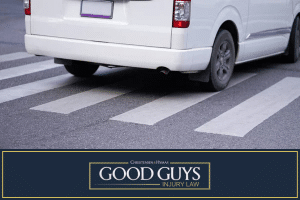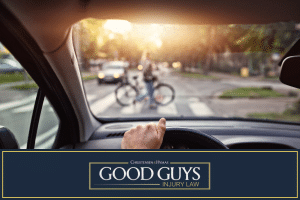The Role of Negligence in Utah Pedestrian Accidents

Every day, pedestrians trust drivers to follow the law and protect their safety. Unfortunately, accidents happen, often due to negligence. Understanding the role of negligence in pedestrian accidents is vital for victims seeking justice. Utah has specific laws that define and deal with negligence in such accidents.
Good Guys Injury Law has a proven track record of representing Utah pedestrians who have suffered due to someone’s negligence. Knowing the ins and outs of Utah’s negligence laws helps us champion our clients effectively. If you have suffered severe injuries, seek medical care as soon as possible. Be sure to request a copy of the police report at the accident scene. Then, give us a call to schedule a free consultation to discuss your Utah pedestrian accident case. We can seek compensation to help you cover medical expenses and property damage.
Table of Contents
Defining Negligence: A Legal Overview From a Utah Pedestrian Accident Attorney
Pedestrian accidents occur when people don’t pay attention. Negligence refers to failing to act with the care a reasonable person would exercise under the same circumstances. This can involve doing something that a cautious individual wouldn’t do or failing to do something that a good person would. In Utah, like many states, negligence plays a critical role in personal injury cases, particularly in cases of pure comparative negligence.
For victims of pedestrian accidents, proving the driver’s negligence is often the key to securing compensation. This requires a clear understanding of how Utah law defines and interprets negligence. The deeper one dives, the more precise the distinction becomes between negligence and other legal terms. We can make sure your rights are protected under Utah law.
How Negligence Differs from Recklessness and Intent

While negligence is an unintentional act of carelessness, recklessness involves conscious disregard for the safety of others. Someone reckless knows their actions can cause harm but proceeds anyway. Intent, however, implies that harm was the desired outcome.
Differentiating between these terms is crucial when seeking justice in court. A driver who was negligent might not have intended harm, but their carelessness caused it. Recognizing the distinctions ensures that responsible parties are held to the appropriate level of accountability. We understand pedestrian laws, and we can gather evidence we can use to pursue the at-fault party.
The Spectrum of Fault: From Inadvertence to Malice
Negligence lies on a spectrum of fault. On one end, we have inadvertence—simple mistakes anyone could make. As we progress, the actions become more egregious, with recklessness marking a significant leap.
Malice, or intentional harm, is at the far end of the spectrum. This is where someone acts intending to injure another. The penalties for each fault differ, so identifying the correct category matters in a legal setting.
The Legal Implications of Each Category
In Utah, the penalties for negligence differ from those for recklessness or intent. Negligence might result in financial compensation for the victim. Recklessness can lead to steeper fines, and intent might even result in criminal charges.
Knowing which category an action falls under can shape a case’s strategy. It determines potential outcomes, compensations, and even public perceptions of the incident.
Real-World Examples: Understanding the Differences
Let’s say a driver failed to notice a stop sign because they were distracted—that’s negligence. If a driver sped through a pedestrian zone because they enjoyed the thrill, that’s recklessness. If someone drives into a crowd with the intent of causing harm, that’s a deliberate act.
Such examples offer clear distinctions between these terms. When you can categorize the action correctly, you can pursue the most fitting legal recourse. Whether someone is drunk, tired, or intentionally trying to hurt someone matters. That is why a full investigation is crucial.
Elements Required to Prove Negligence in Utah
To establish negligence in Utah, certain elements must be proven. They include:
- Duty: Every driver must operate their vehicle safely. Drivers are expected to obey traffic laws and remain vigilant. This duty exists to protect everyone on the road, including pedestrians.
- Breach: This involves proving that the driver failed in their duty. For instance, if a driver was texting and hit a pedestrian, they breached their duty. This breach is a deviation from what a careful person would do.
- Causation: The breach of duty should directly result in injury. Simply put, the negligent act must be the reason for the harm. It can’t be a mere coincidence or an unrelated event.
- Damages: The victim must have suffered some form of harm. This could be physical injury, emotional trauma, or financial loss. Without damages, there’s no basis for a claim, even if negligence occurred.
Once these elements align, a pedestrian accident victim in Utah has a solid foundation for a negligence claim.
Comparative Negligence: When Both Parties Share Fault

Sometimes, both the pedestrian and the driver might share fault in an accident. Utah follows a modified comparative negligence rule. This means that if a pedestrian is found 50% or more at fault, they cannot recover damages.
It’s essential to understand this rule as it can significantly impact the outcome of a claim. Proper legal representation ensures that fault percentages are determined relatively.
The Impact of Negligence on Compensation Claims
Negligence directly impacts the amount of compensation a victim can seek. If a driver’s negligence caused the accident, the injured pedestrian might claim medical expenses, lost wages, and more. However, if the pedestrian shares some blame, their compensation can be reduced proportionally.
This relationship between negligence and compensation is why gathering evidence and building a solid case is crucial. With the correct information and strategy, victims can ensure they receive the compensation they rightfully deserve.
Common Situations Where Negligence Occurs

Every pedestrian accident is unique, but some scenarios are alarmingly common. These often involve drivers needing to pay attention, speed, or yield the right of way to pedestrians.
Distracted Driving: A Modern Menace
Distracted driving, like texting or adjusting the radio, has become a leading cause of accidents. Drivers who aren’t focused on the road can easily overlook pedestrians. Sadly, even a few seconds of distraction can lead to catastrophic results.
Technological advancements have brought many conveniences. Yet, they’ve also introduced new challenges on the road. It’s crucial for drivers to recognize these dangers and for victims to be aware of their rights.
Poor Road Infrastructure and its Consequences
Sometimes, accidents happen due to poorly designed or maintained roads. Uneven surfaces, lack of proper signage, or inadequate lighting can contribute to accidents. While drivers should still exercise caution, such factors can increase the risk of pedestrian incidents.
Municipalities have a responsibility to ensure safe infrastructure. They might be held accountable for any resulting accidents when they fail this duty.
The Perils of Intoxication: Alcohol and Drugs
Driving under the influence is still a significant issue. Alcohol or drugs impair judgment, reaction time, and coordination. Intoxicated drivers pose a considerable risk to pedestrians, often leading to severe or fatal accidents.
Understanding the dangers of driving under the influence can deter potential offenders. For victims, knowing the legal implications can be a path to justice.
Documenting Evidence of Negligence After an Accident
If you’re involved in a pedestrian accident, collecting evidence is vital. Photos of the scene, witness testimonies, and medical records can all support a negligence claim. Such documentation provides a clearer picture of what transpired.
Legal professionals can also help gather and present this evidence. Their expertise ensures that all pertinent information gets considered, increasing the chances of a successful claim.
How Expert Witnesses Can Help Prove Negligence
Expert witnesses bring specialized knowledge to a case. They might be medical professionals, accident reconstructionists, or traffic safety experts. Their testimony can shed light on specific details, often swaying a case in the victim’s favor.
Having an expert witness can enhance a case’s credibility. Their insights can clarify complex matters, making it easier for a jury or judge to understand the events and the negligence involved.
Protecting Your Rights: What to Do if You Suspect Negligence
If you believe negligence caused your pedestrian accident:
- Seek Medical Attention: Always prioritize your health. Even if injuries seem minor, they might worsen over time. A medical report can also serve as evidence.
- Document Everything: Take photos and gather witness contact details. This evidence can be invaluable when proving negligence. Memories can fade, but documented proof remains.
- Avoid Discussing Fault: Don’t admit fault or discuss the accident’s details with anyone but your attorney. What you say can be used against you. It’s best to let legal professionals handle such communications.
- Contact an Attorney: Engage a pedestrian accident attorney as soon as possible. They can guide you through the legal process. Their knowledge can boost the chances of a favorable outcome.
- Stay Informed: Understand your rights and the legal process. Being informed empowers you to make the best decisions. It also ensures you’re prepared for every step of the journey.
By taking these steps, you can protect your rights and interests after a pedestrian accident in Utah.
Contact Good Guys Injury Law for Your Utah Pedestrian Accident Attorney

If you or a loved one suffered due to a pedestrian accident in Utah, you need representation you can trust. Good Guys Injury Law stands by your side, helping you navigate the complexities of negligence laws.
Our team understands the emotional and physical turmoil such accidents can cause. We’re here to offer guidance, support, and relentless advocacy.
Reach out today, and let us fight for the justice you deserve.
